Activity Based Costing Model: Implementation in CSL Limited
VerifiedAdded on 2023/06/13
|10
|2693
|393
Report
AI Summary
This report provides an in-depth analysis of the Activity Based Costing (ABC) model and its potential benefits for CSL Limited, a global biotechnology company. It examines the features of the ABC model, highlighting its advantages over traditional costing methods in accurately allocating overhead costs to various activities. The report discusses how the ABC model can align with CSL Limited's strategic goals, particularly in research and development, by providing detailed cost information for better decision-making and cost control. Recommendations are made for the implementation of the ABC model within CSL Limited, including cost driver and activity analysis. Additionally, the report suggests the adoption of a top-down costing model to further enhance cost management in clinical activities. The ultimate goal is to improve operational efficiency, support strategic priorities, and achieve long-term objectives through effective cost management practices.

1
Activity Based Costing
Activity Based Costing
Paraphrase This Document
Need a fresh take? Get an instant paraphrase of this document with our AI Paraphraser
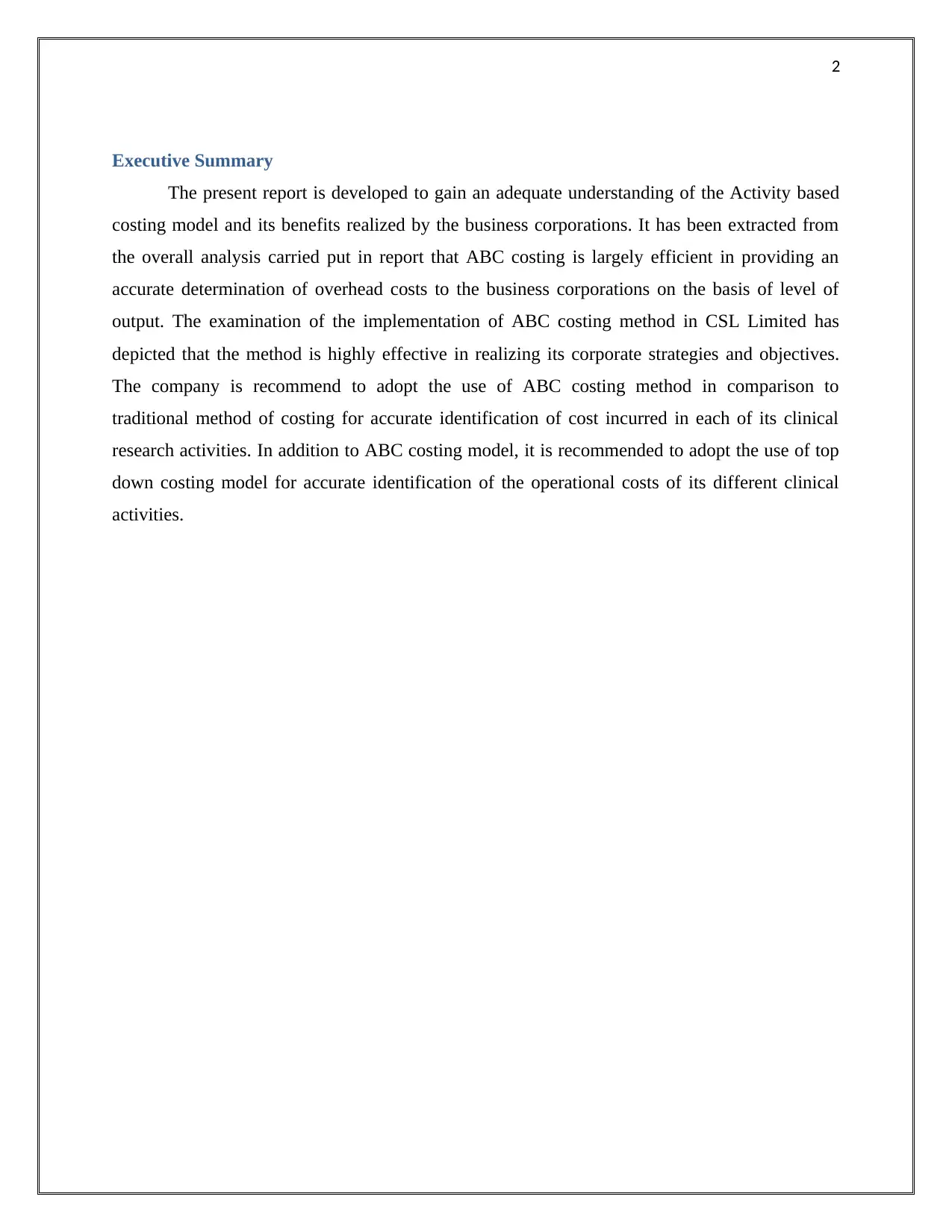
2
Executive Summary
The present report is developed to gain an adequate understanding of the Activity based
costing model and its benefits realized by the business corporations. It has been extracted from
the overall analysis carried put in report that ABC costing is largely efficient in providing an
accurate determination of overhead costs to the business corporations on the basis of level of
output. The examination of the implementation of ABC costing method in CSL Limited has
depicted that the method is highly effective in realizing its corporate strategies and objectives.
The company is recommend to adopt the use of ABC costing method in comparison to
traditional method of costing for accurate identification of cost incurred in each of its clinical
research activities. In addition to ABC costing model, it is recommended to adopt the use of top
down costing model for accurate identification of the operational costs of its different clinical
activities.
Executive Summary
The present report is developed to gain an adequate understanding of the Activity based
costing model and its benefits realized by the business corporations. It has been extracted from
the overall analysis carried put in report that ABC costing is largely efficient in providing an
accurate determination of overhead costs to the business corporations on the basis of level of
output. The examination of the implementation of ABC costing method in CSL Limited has
depicted that the method is highly effective in realizing its corporate strategies and objectives.
The company is recommend to adopt the use of ABC costing method in comparison to
traditional method of costing for accurate identification of cost incurred in each of its clinical
research activities. In addition to ABC costing model, it is recommended to adopt the use of top
down costing model for accurate identification of the operational costs of its different clinical
activities.
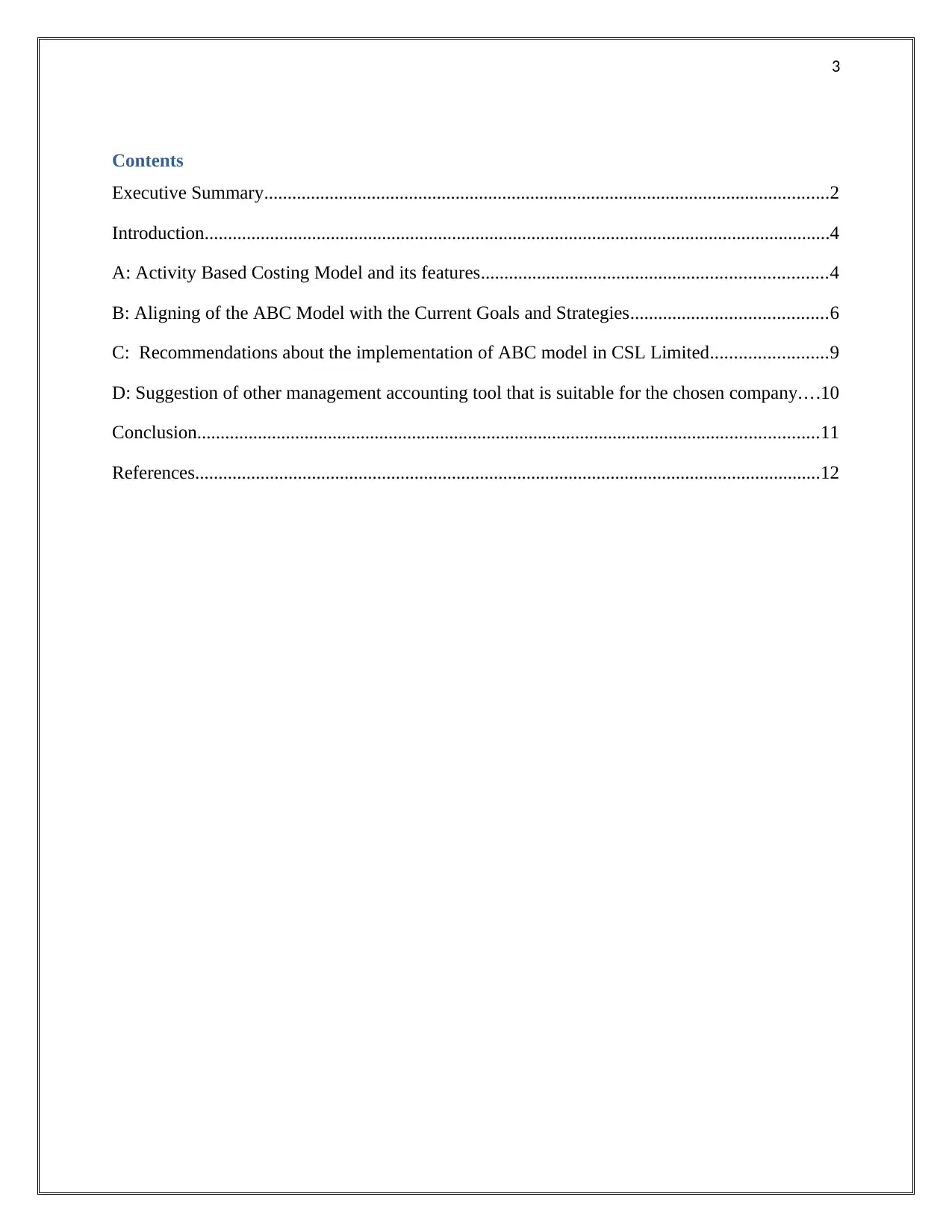
3
Contents
Executive Summary.........................................................................................................................2
Introduction......................................................................................................................................4
A: Activity Based Costing Model and its features..........................................................................4
B: Aligning of the ABC Model with the Current Goals and Strategies..........................................6
C: Recommendations about the implementation of ABC model in CSL Limited.........................9
D: Suggestion of other management accounting tool that is suitable for the chosen company....10
Conclusion.....................................................................................................................................11
References......................................................................................................................................12
Contents
Executive Summary.........................................................................................................................2
Introduction......................................................................................................................................4
A: Activity Based Costing Model and its features..........................................................................4
B: Aligning of the ABC Model with the Current Goals and Strategies..........................................6
C: Recommendations about the implementation of ABC model in CSL Limited.........................9
D: Suggestion of other management accounting tool that is suitable for the chosen company....10
Conclusion.....................................................................................................................................11
References......................................................................................................................................12
⊘ This is a preview!⊘
Do you want full access?
Subscribe today to unlock all pages.

Trusted by 1+ million students worldwide
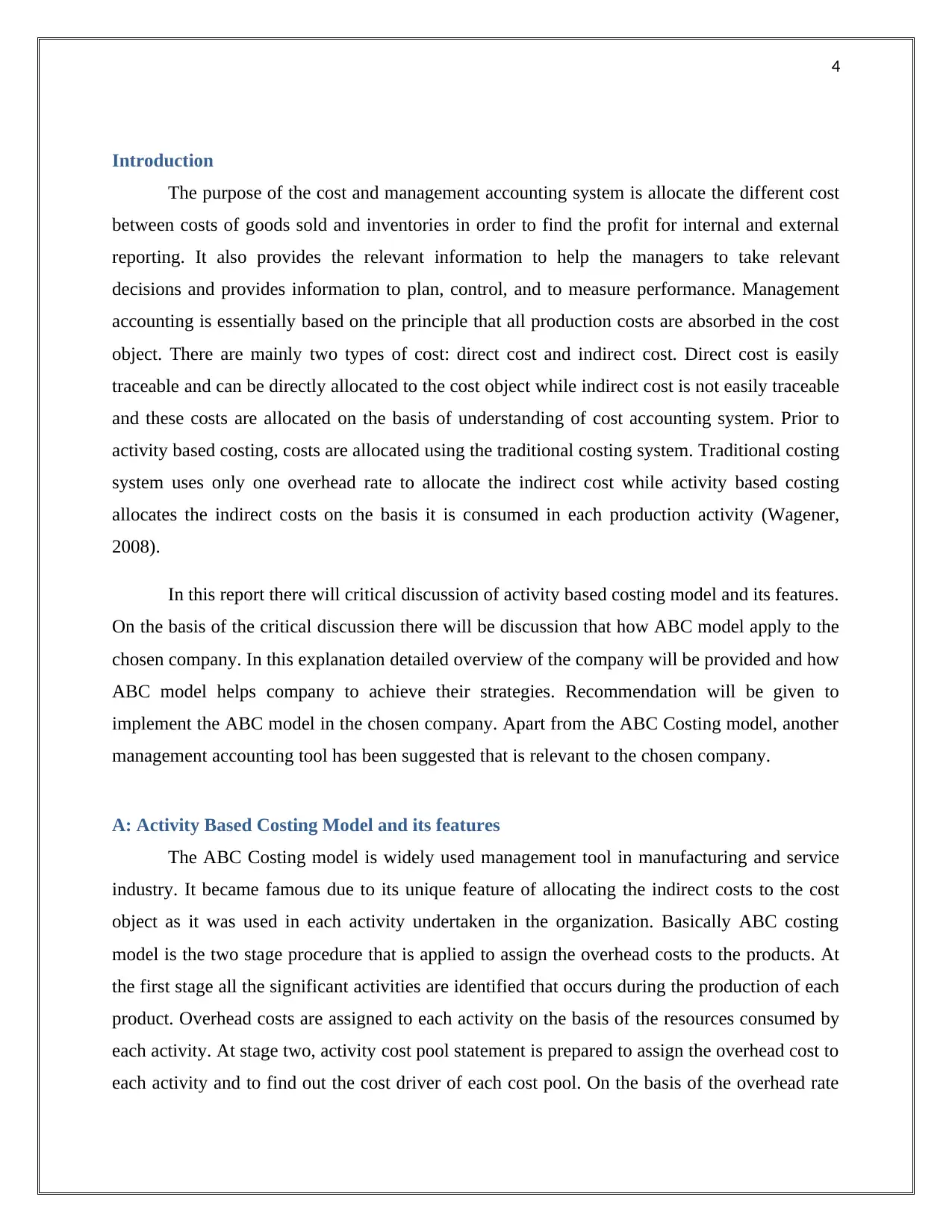
4
Introduction
The purpose of the cost and management accounting system is allocate the different cost
between costs of goods sold and inventories in order to find the profit for internal and external
reporting. It also provides the relevant information to help the managers to take relevant
decisions and provides information to plan, control, and to measure performance. Management
accounting is essentially based on the principle that all production costs are absorbed in the cost
object. There are mainly two types of cost: direct cost and indirect cost. Direct cost is easily
traceable and can be directly allocated to the cost object while indirect cost is not easily traceable
and these costs are allocated on the basis of understanding of cost accounting system. Prior to
activity based costing, costs are allocated using the traditional costing system. Traditional costing
system uses only one overhead rate to allocate the indirect cost while activity based costing
allocates the indirect costs on the basis it is consumed in each production activity (Wagener,
2008).
In this report there will critical discussion of activity based costing model and its features.
On the basis of the critical discussion there will be discussion that how ABC model apply to the
chosen company. In this explanation detailed overview of the company will be provided and how
ABC model helps company to achieve their strategies. Recommendation will be given to
implement the ABC model in the chosen company. Apart from the ABC Costing model, another
management accounting tool has been suggested that is relevant to the chosen company.
A: Activity Based Costing Model and its features
The ABC Costing model is widely used management tool in manufacturing and service
industry. It became famous due to its unique feature of allocating the indirect costs to the cost
object as it was used in each activity undertaken in the organization. Basically ABC costing
model is the two stage procedure that is applied to assign the overhead costs to the products. At
the first stage all the significant activities are identified that occurs during the production of each
product. Overhead costs are assigned to each activity on the basis of the resources consumed by
each activity. At stage two, activity cost pool statement is prepared to assign the overhead cost to
each activity and to find out the cost driver of each cost pool. On the basis of the overhead rate
Introduction
The purpose of the cost and management accounting system is allocate the different cost
between costs of goods sold and inventories in order to find the profit for internal and external
reporting. It also provides the relevant information to help the managers to take relevant
decisions and provides information to plan, control, and to measure performance. Management
accounting is essentially based on the principle that all production costs are absorbed in the cost
object. There are mainly two types of cost: direct cost and indirect cost. Direct cost is easily
traceable and can be directly allocated to the cost object while indirect cost is not easily traceable
and these costs are allocated on the basis of understanding of cost accounting system. Prior to
activity based costing, costs are allocated using the traditional costing system. Traditional costing
system uses only one overhead rate to allocate the indirect cost while activity based costing
allocates the indirect costs on the basis it is consumed in each production activity (Wagener,
2008).
In this report there will critical discussion of activity based costing model and its features.
On the basis of the critical discussion there will be discussion that how ABC model apply to the
chosen company. In this explanation detailed overview of the company will be provided and how
ABC model helps company to achieve their strategies. Recommendation will be given to
implement the ABC model in the chosen company. Apart from the ABC Costing model, another
management accounting tool has been suggested that is relevant to the chosen company.
A: Activity Based Costing Model and its features
The ABC Costing model is widely used management tool in manufacturing and service
industry. It became famous due to its unique feature of allocating the indirect costs to the cost
object as it was used in each activity undertaken in the organization. Basically ABC costing
model is the two stage procedure that is applied to assign the overhead costs to the products. At
the first stage all the significant activities are identified that occurs during the production of each
product. Overhead costs are assigned to each activity on the basis of the resources consumed by
each activity. At stage two, activity cost pool statement is prepared to assign the overhead cost to
each activity and to find out the cost driver of each cost pool. On the basis of the overhead rate
Paraphrase This Document
Need a fresh take? Get an instant paraphrase of this document with our AI Paraphraser
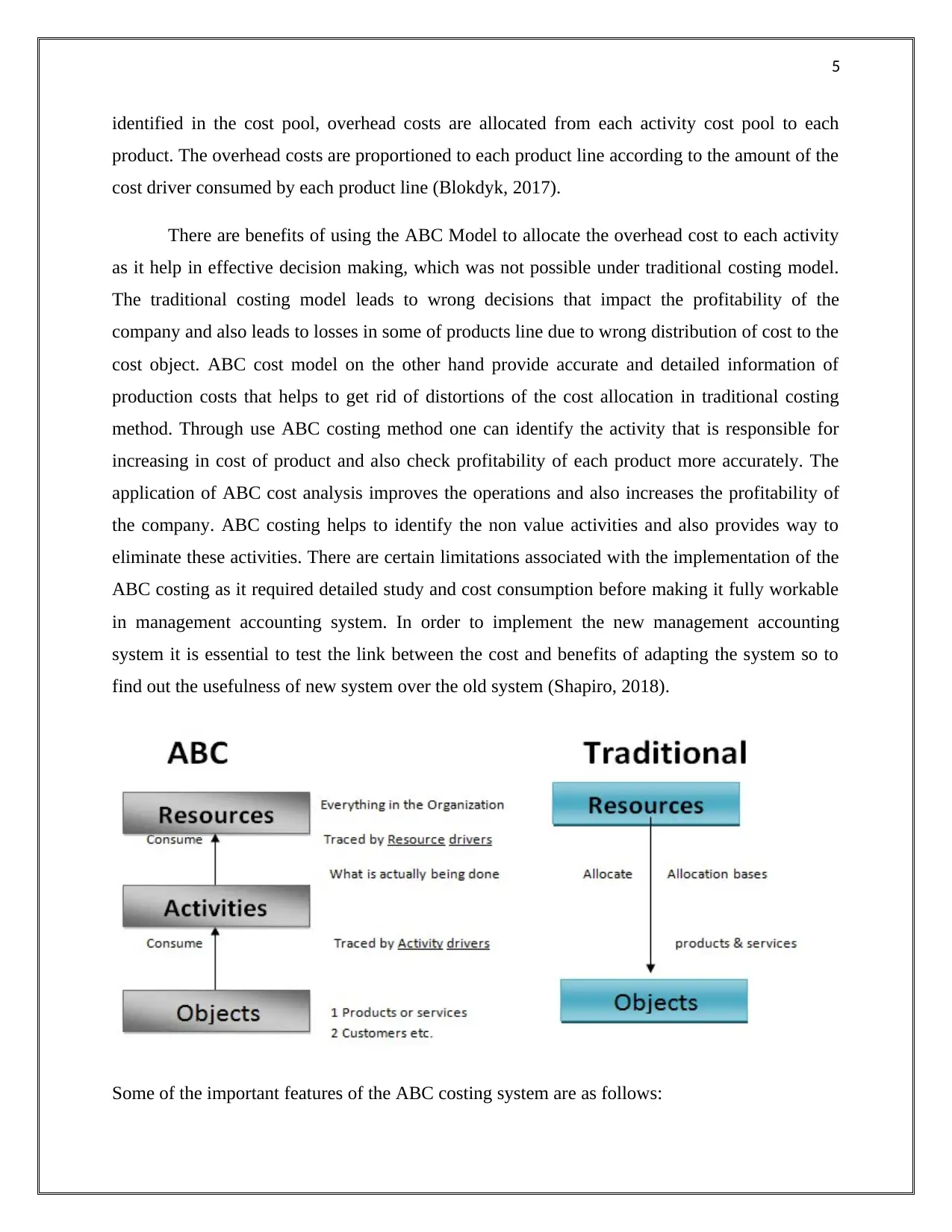
5
identified in the cost pool, overhead costs are allocated from each activity cost pool to each
product. The overhead costs are proportioned to each product line according to the amount of the
cost driver consumed by each product line (Blokdyk, 2017).
There are benefits of using the ABC Model to allocate the overhead cost to each activity
as it help in effective decision making, which was not possible under traditional costing model.
The traditional costing model leads to wrong decisions that impact the profitability of the
company and also leads to losses in some of products line due to wrong distribution of cost to the
cost object. ABC cost model on the other hand provide accurate and detailed information of
production costs that helps to get rid of distortions of the cost allocation in traditional costing
method. Through use ABC costing method one can identify the activity that is responsible for
increasing in cost of product and also check profitability of each product more accurately. The
application of ABC cost analysis improves the operations and also increases the profitability of
the company. ABC costing helps to identify the non value activities and also provides way to
eliminate these activities. There are certain limitations associated with the implementation of the
ABC costing as it required detailed study and cost consumption before making it fully workable
in management accounting system. In order to implement the new management accounting
system it is essential to test the link between the cost and benefits of adapting the system so to
find out the usefulness of new system over the old system (Shapiro, 2018).
Some of the important features of the ABC costing system are as follows:
identified in the cost pool, overhead costs are allocated from each activity cost pool to each
product. The overhead costs are proportioned to each product line according to the amount of the
cost driver consumed by each product line (Blokdyk, 2017).
There are benefits of using the ABC Model to allocate the overhead cost to each activity
as it help in effective decision making, which was not possible under traditional costing model.
The traditional costing model leads to wrong decisions that impact the profitability of the
company and also leads to losses in some of products line due to wrong distribution of cost to the
cost object. ABC cost model on the other hand provide accurate and detailed information of
production costs that helps to get rid of distortions of the cost allocation in traditional costing
method. Through use ABC costing method one can identify the activity that is responsible for
increasing in cost of product and also check profitability of each product more accurately. The
application of ABC cost analysis improves the operations and also increases the profitability of
the company. ABC costing helps to identify the non value activities and also provides way to
eliminate these activities. There are certain limitations associated with the implementation of the
ABC costing as it required detailed study and cost consumption before making it fully workable
in management accounting system. In order to implement the new management accounting
system it is essential to test the link between the cost and benefits of adapting the system so to
find out the usefulness of new system over the old system (Shapiro, 2018).
Some of the important features of the ABC costing system are as follows:
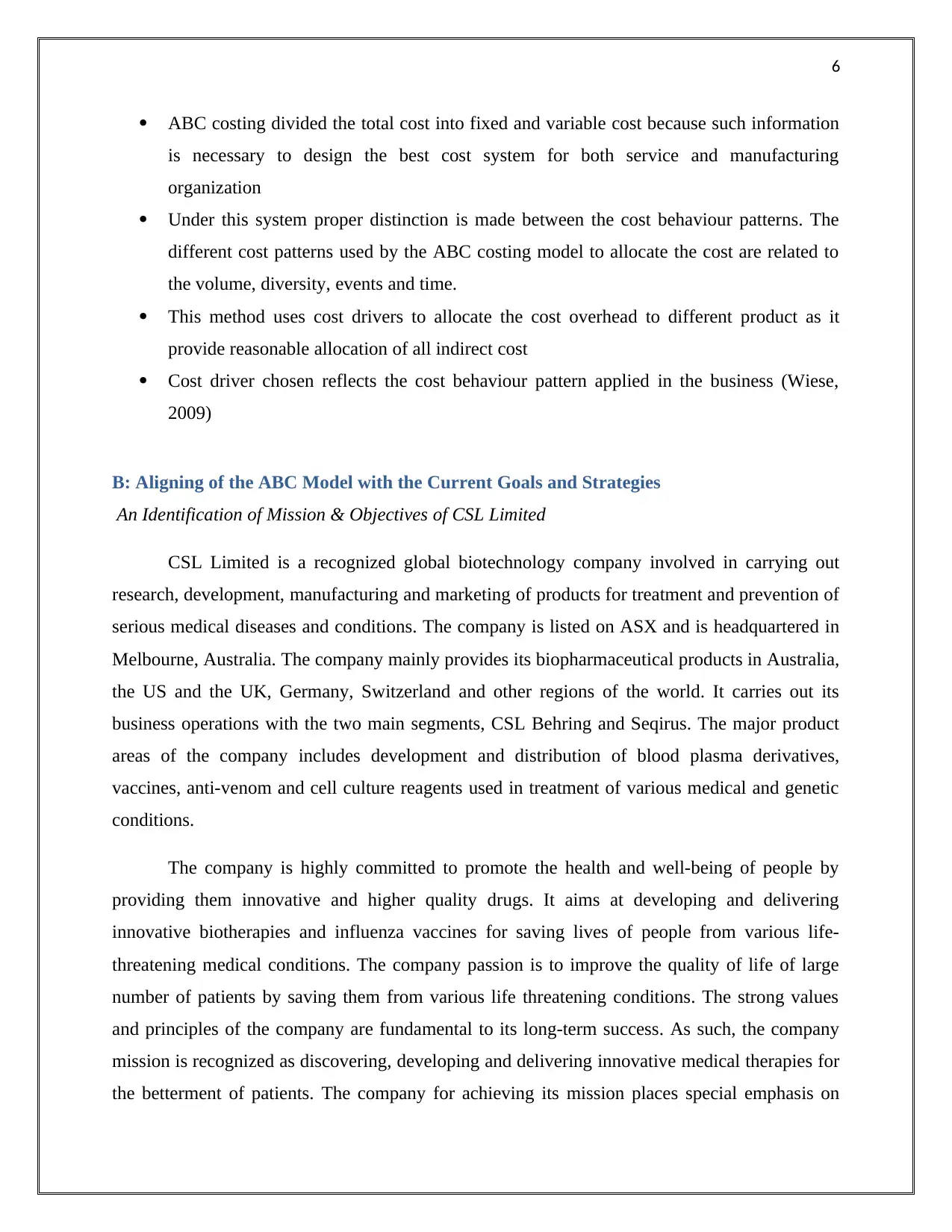
6
ABC costing divided the total cost into fixed and variable cost because such information
is necessary to design the best cost system for both service and manufacturing
organization
Under this system proper distinction is made between the cost behaviour patterns. The
different cost patterns used by the ABC costing model to allocate the cost are related to
the volume, diversity, events and time.
This method uses cost drivers to allocate the cost overhead to different product as it
provide reasonable allocation of all indirect cost
Cost driver chosen reflects the cost behaviour pattern applied in the business (Wiese,
2009)
B: Aligning of the ABC Model with the Current Goals and Strategies
An Identification of Mission & Objectives of CSL Limited
CSL Limited is a recognized global biotechnology company involved in carrying out
research, development, manufacturing and marketing of products for treatment and prevention of
serious medical diseases and conditions. The company is listed on ASX and is headquartered in
Melbourne, Australia. The company mainly provides its biopharmaceutical products in Australia,
the US and the UK, Germany, Switzerland and other regions of the world. It carries out its
business operations with the two main segments, CSL Behring and Seqirus. The major product
areas of the company includes development and distribution of blood plasma derivatives,
vaccines, anti-venom and cell culture reagents used in treatment of various medical and genetic
conditions.
The company is highly committed to promote the health and well-being of people by
providing them innovative and higher quality drugs. It aims at developing and delivering
innovative biotherapies and influenza vaccines for saving lives of people from various life-
threatening medical conditions. The company passion is to improve the quality of life of large
number of patients by saving them from various life threatening conditions. The strong values
and principles of the company are fundamental to its long-term success. As such, the company
mission is recognized as discovering, developing and delivering innovative medical therapies for
the betterment of patients. The company for achieving its mission places special emphasis on
ABC costing divided the total cost into fixed and variable cost because such information
is necessary to design the best cost system for both service and manufacturing
organization
Under this system proper distinction is made between the cost behaviour patterns. The
different cost patterns used by the ABC costing model to allocate the cost are related to
the volume, diversity, events and time.
This method uses cost drivers to allocate the cost overhead to different product as it
provide reasonable allocation of all indirect cost
Cost driver chosen reflects the cost behaviour pattern applied in the business (Wiese,
2009)
B: Aligning of the ABC Model with the Current Goals and Strategies
An Identification of Mission & Objectives of CSL Limited
CSL Limited is a recognized global biotechnology company involved in carrying out
research, development, manufacturing and marketing of products for treatment and prevention of
serious medical diseases and conditions. The company is listed on ASX and is headquartered in
Melbourne, Australia. The company mainly provides its biopharmaceutical products in Australia,
the US and the UK, Germany, Switzerland and other regions of the world. It carries out its
business operations with the two main segments, CSL Behring and Seqirus. The major product
areas of the company includes development and distribution of blood plasma derivatives,
vaccines, anti-venom and cell culture reagents used in treatment of various medical and genetic
conditions.
The company is highly committed to promote the health and well-being of people by
providing them innovative and higher quality drugs. It aims at developing and delivering
innovative biotherapies and influenza vaccines for saving lives of people from various life-
threatening medical conditions. The company passion is to improve the quality of life of large
number of patients by saving them from various life threatening conditions. The strong values
and principles of the company are fundamental to its long-term success. As such, the company
mission is recognized as discovering, developing and delivering innovative medical therapies for
the betterment of patients. The company for achieving its mission places special emphasis on
⊘ This is a preview!⊘
Do you want full access?
Subscribe today to unlock all pages.

Trusted by 1+ million students worldwide
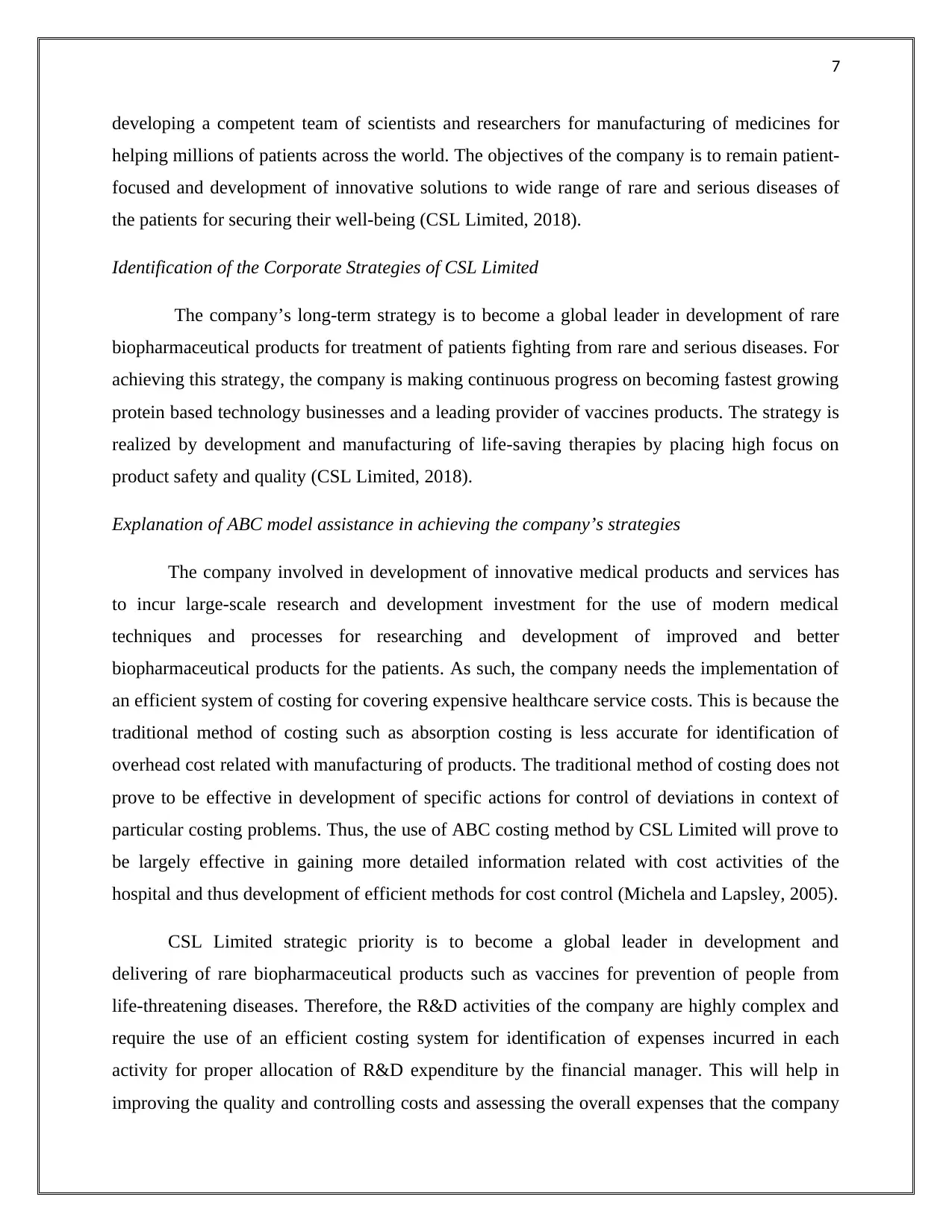
7
developing a competent team of scientists and researchers for manufacturing of medicines for
helping millions of patients across the world. The objectives of the company is to remain patient-
focused and development of innovative solutions to wide range of rare and serious diseases of
the patients for securing their well-being (CSL Limited, 2018).
Identification of the Corporate Strategies of CSL Limited
The company’s long-term strategy is to become a global leader in development of rare
biopharmaceutical products for treatment of patients fighting from rare and serious diseases. For
achieving this strategy, the company is making continuous progress on becoming fastest growing
protein based technology businesses and a leading provider of vaccines products. The strategy is
realized by development and manufacturing of life-saving therapies by placing high focus on
product safety and quality (CSL Limited, 2018).
Explanation of ABC model assistance in achieving the company’s strategies
The company involved in development of innovative medical products and services has
to incur large-scale research and development investment for the use of modern medical
techniques and processes for researching and development of improved and better
biopharmaceutical products for the patients. As such, the company needs the implementation of
an efficient system of costing for covering expensive healthcare service costs. This is because the
traditional method of costing such as absorption costing is less accurate for identification of
overhead cost related with manufacturing of products. The traditional method of costing does not
prove to be effective in development of specific actions for control of deviations in context of
particular costing problems. Thus, the use of ABC costing method by CSL Limited will prove to
be largely effective in gaining more detailed information related with cost activities of the
hospital and thus development of efficient methods for cost control (Michela and Lapsley, 2005).
CSL Limited strategic priority is to become a global leader in development and
delivering of rare biopharmaceutical products such as vaccines for prevention of people from
life-threatening diseases. Therefore, the R&D activities of the company are highly complex and
require the use of an efficient costing system for identification of expenses incurred in each
activity for proper allocation of R&D expenditure by the financial manager. This will help in
improving the quality and controlling costs and assessing the overall expenses that the company
developing a competent team of scientists and researchers for manufacturing of medicines for
helping millions of patients across the world. The objectives of the company is to remain patient-
focused and development of innovative solutions to wide range of rare and serious diseases of
the patients for securing their well-being (CSL Limited, 2018).
Identification of the Corporate Strategies of CSL Limited
The company’s long-term strategy is to become a global leader in development of rare
biopharmaceutical products for treatment of patients fighting from rare and serious diseases. For
achieving this strategy, the company is making continuous progress on becoming fastest growing
protein based technology businesses and a leading provider of vaccines products. The strategy is
realized by development and manufacturing of life-saving therapies by placing high focus on
product safety and quality (CSL Limited, 2018).
Explanation of ABC model assistance in achieving the company’s strategies
The company involved in development of innovative medical products and services has
to incur large-scale research and development investment for the use of modern medical
techniques and processes for researching and development of improved and better
biopharmaceutical products for the patients. As such, the company needs the implementation of
an efficient system of costing for covering expensive healthcare service costs. This is because the
traditional method of costing such as absorption costing is less accurate for identification of
overhead cost related with manufacturing of products. The traditional method of costing does not
prove to be effective in development of specific actions for control of deviations in context of
particular costing problems. Thus, the use of ABC costing method by CSL Limited will prove to
be largely effective in gaining more detailed information related with cost activities of the
hospital and thus development of efficient methods for cost control (Michela and Lapsley, 2005).
CSL Limited strategic priority is to become a global leader in development and
delivering of rare biopharmaceutical products such as vaccines for prevention of people from
life-threatening diseases. Therefore, the R&D activities of the company are highly complex and
require the use of an efficient costing system for identification of expenses incurred in each
activity for proper allocation of R&D expenditure by the financial manager. This will help in
improving the quality and controlling costs and assessing the overall expenses that the company
Paraphrase This Document
Need a fresh take? Get an instant paraphrase of this document with our AI Paraphraser
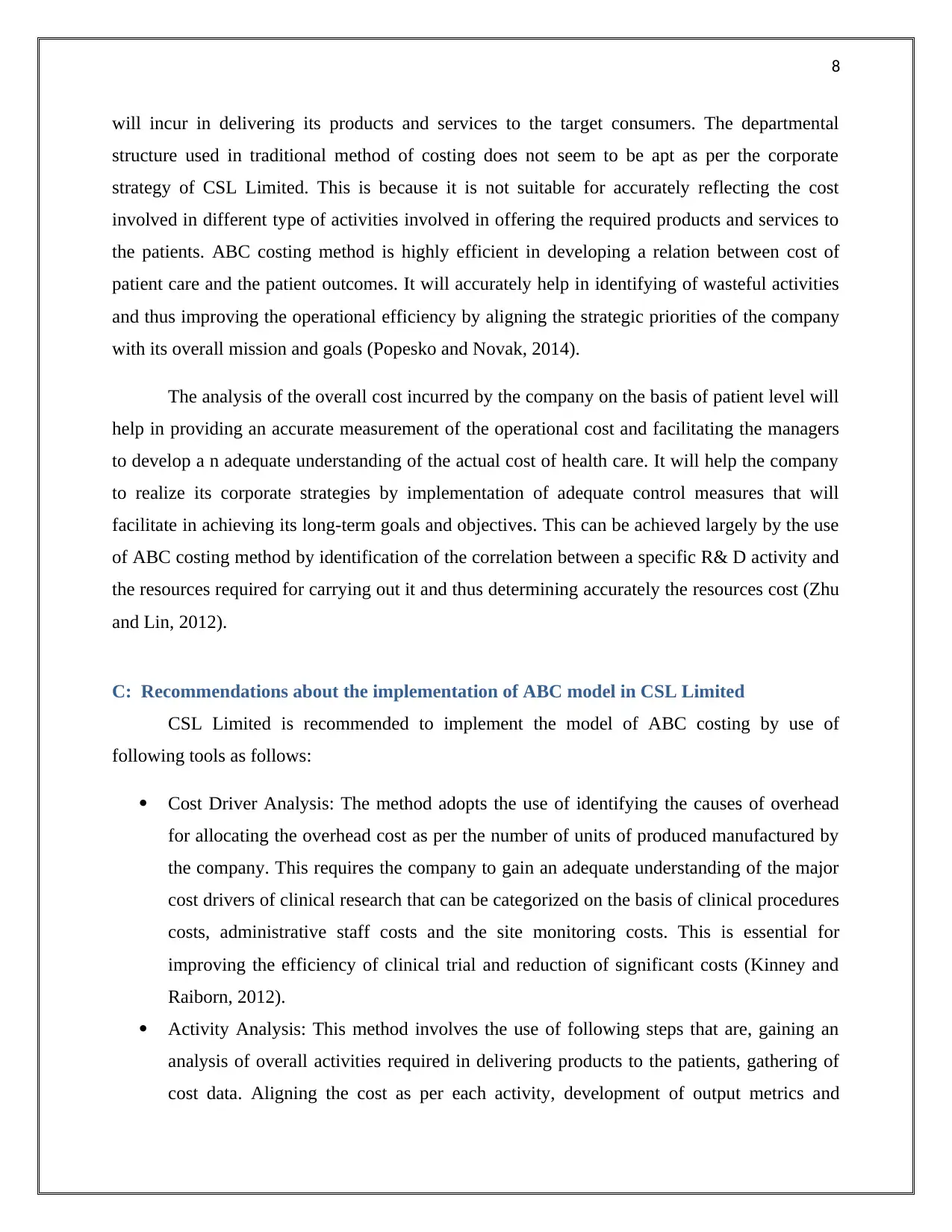
8
will incur in delivering its products and services to the target consumers. The departmental
structure used in traditional method of costing does not seem to be apt as per the corporate
strategy of CSL Limited. This is because it is not suitable for accurately reflecting the cost
involved in different type of activities involved in offering the required products and services to
the patients. ABC costing method is highly efficient in developing a relation between cost of
patient care and the patient outcomes. It will accurately help in identifying of wasteful activities
and thus improving the operational efficiency by aligning the strategic priorities of the company
with its overall mission and goals (Popesko and Novak, 2014).
The analysis of the overall cost incurred by the company on the basis of patient level will
help in providing an accurate measurement of the operational cost and facilitating the managers
to develop a n adequate understanding of the actual cost of health care. It will help the company
to realize its corporate strategies by implementation of adequate control measures that will
facilitate in achieving its long-term goals and objectives. This can be achieved largely by the use
of ABC costing method by identification of the correlation between a specific R& D activity and
the resources required for carrying out it and thus determining accurately the resources cost (Zhu
and Lin, 2012).
C: Recommendations about the implementation of ABC model in CSL Limited
CSL Limited is recommended to implement the model of ABC costing by use of
following tools as follows:
Cost Driver Analysis: The method adopts the use of identifying the causes of overhead
for allocating the overhead cost as per the number of units of produced manufactured by
the company. This requires the company to gain an adequate understanding of the major
cost drivers of clinical research that can be categorized on the basis of clinical procedures
costs, administrative staff costs and the site monitoring costs. This is essential for
improving the efficiency of clinical trial and reduction of significant costs (Kinney and
Raiborn, 2012).
Activity Analysis: This method involves the use of following steps that are, gaining an
analysis of overall activities required in delivering products to the patients, gathering of
cost data. Aligning the cost as per each activity, development of output metrics and
will incur in delivering its products and services to the target consumers. The departmental
structure used in traditional method of costing does not seem to be apt as per the corporate
strategy of CSL Limited. This is because it is not suitable for accurately reflecting the cost
involved in different type of activities involved in offering the required products and services to
the patients. ABC costing method is highly efficient in developing a relation between cost of
patient care and the patient outcomes. It will accurately help in identifying of wasteful activities
and thus improving the operational efficiency by aligning the strategic priorities of the company
with its overall mission and goals (Popesko and Novak, 2014).
The analysis of the overall cost incurred by the company on the basis of patient level will
help in providing an accurate measurement of the operational cost and facilitating the managers
to develop a n adequate understanding of the actual cost of health care. It will help the company
to realize its corporate strategies by implementation of adequate control measures that will
facilitate in achieving its long-term goals and objectives. This can be achieved largely by the use
of ABC costing method by identification of the correlation between a specific R& D activity and
the resources required for carrying out it and thus determining accurately the resources cost (Zhu
and Lin, 2012).
C: Recommendations about the implementation of ABC model in CSL Limited
CSL Limited is recommended to implement the model of ABC costing by use of
following tools as follows:
Cost Driver Analysis: The method adopts the use of identifying the causes of overhead
for allocating the overhead cost as per the number of units of produced manufactured by
the company. This requires the company to gain an adequate understanding of the major
cost drivers of clinical research that can be categorized on the basis of clinical procedures
costs, administrative staff costs and the site monitoring costs. This is essential for
improving the efficiency of clinical trial and reduction of significant costs (Kinney and
Raiborn, 2012).
Activity Analysis: This method involves the use of following steps that are, gaining an
analysis of overall activities required in delivering products to the patients, gathering of
cost data. Aligning the cost as per each activity, development of output metrics and
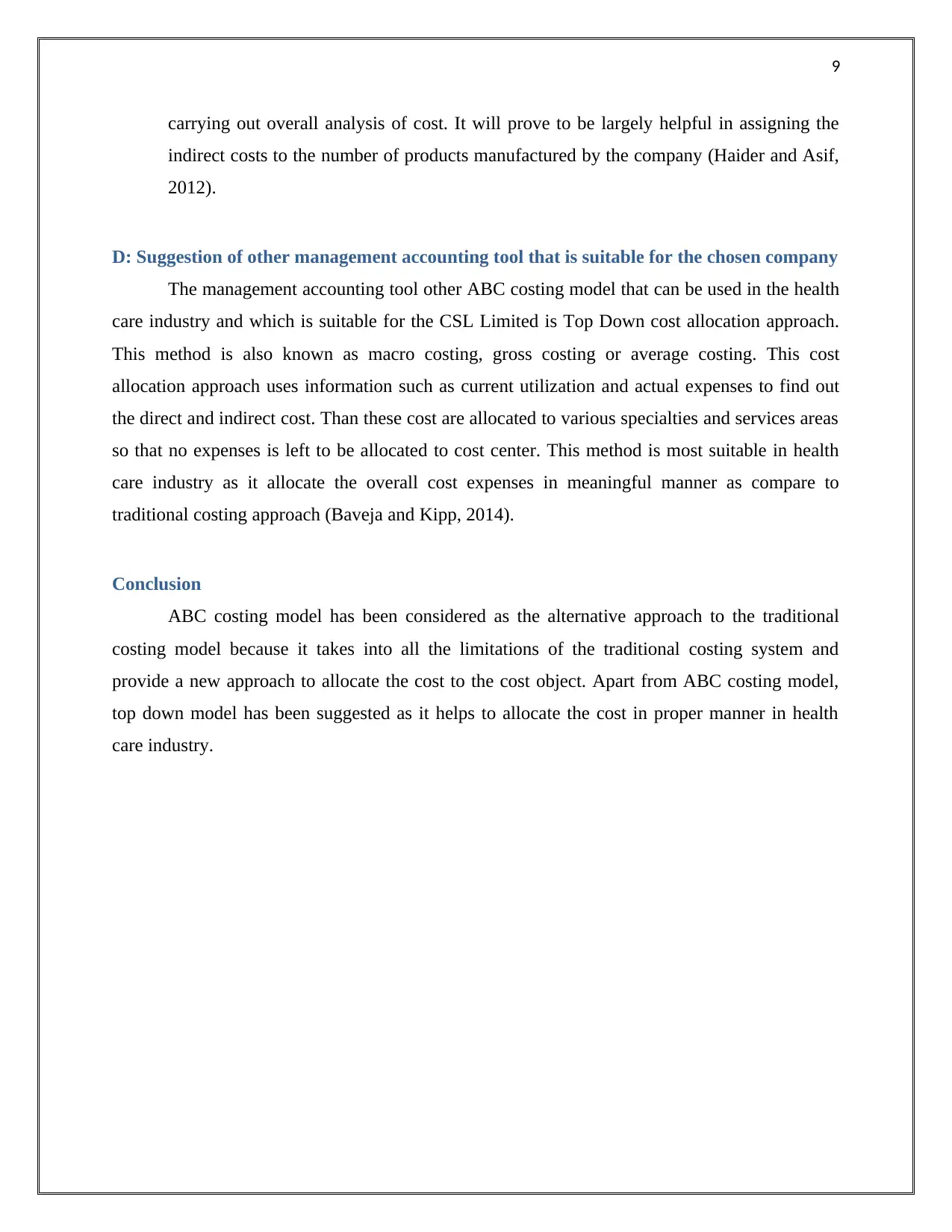
9
carrying out overall analysis of cost. It will prove to be largely helpful in assigning the
indirect costs to the number of products manufactured by the company (Haider and Asif,
2012).
D: Suggestion of other management accounting tool that is suitable for the chosen company
The management accounting tool other ABC costing model that can be used in the health
care industry and which is suitable for the CSL Limited is Top Down cost allocation approach.
This method is also known as macro costing, gross costing or average costing. This cost
allocation approach uses information such as current utilization and actual expenses to find out
the direct and indirect cost. Than these cost are allocated to various specialties and services areas
so that no expenses is left to be allocated to cost center. This method is most suitable in health
care industry as it allocate the overall cost expenses in meaningful manner as compare to
traditional costing approach (Baveja and Kipp, 2014).
Conclusion
ABC costing model has been considered as the alternative approach to the traditional
costing model because it takes into all the limitations of the traditional costing system and
provide a new approach to allocate the cost to the cost object. Apart from ABC costing model,
top down model has been suggested as it helps to allocate the cost in proper manner in health
care industry.
carrying out overall analysis of cost. It will prove to be largely helpful in assigning the
indirect costs to the number of products manufactured by the company (Haider and Asif,
2012).
D: Suggestion of other management accounting tool that is suitable for the chosen company
The management accounting tool other ABC costing model that can be used in the health
care industry and which is suitable for the CSL Limited is Top Down cost allocation approach.
This method is also known as macro costing, gross costing or average costing. This cost
allocation approach uses information such as current utilization and actual expenses to find out
the direct and indirect cost. Than these cost are allocated to various specialties and services areas
so that no expenses is left to be allocated to cost center. This method is most suitable in health
care industry as it allocate the overall cost expenses in meaningful manner as compare to
traditional costing approach (Baveja and Kipp, 2014).
Conclusion
ABC costing model has been considered as the alternative approach to the traditional
costing model because it takes into all the limitations of the traditional costing system and
provide a new approach to allocate the cost to the cost object. Apart from ABC costing model,
top down model has been suggested as it helps to allocate the cost in proper manner in health
care industry.
⊘ This is a preview!⊘
Do you want full access?
Subscribe today to unlock all pages.

Trusted by 1+ million students worldwide
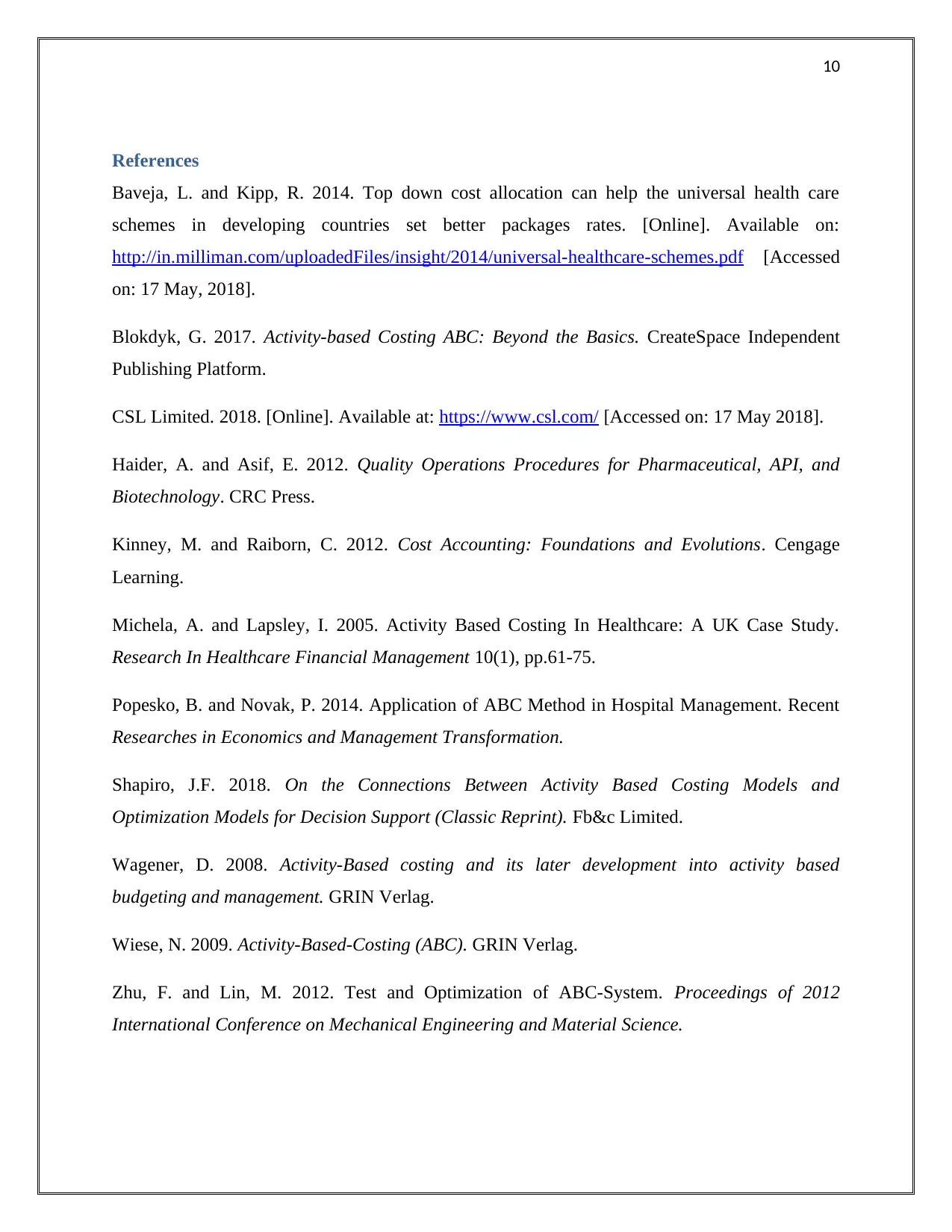
10
References
Baveja, L. and Kipp, R. 2014. Top down cost allocation can help the universal health care
schemes in developing countries set better packages rates. [Online]. Available on:
http://in.milliman.com/uploadedFiles/insight/2014/universal-healthcare-schemes.pdf [Accessed
on: 17 May, 2018].
Blokdyk, G. 2017. Activity-based Costing ABC: Beyond the Basics. CreateSpace Independent
Publishing Platform.
CSL Limited. 2018. [Online]. Available at: https://www.csl.com/ [Accessed on: 17 May 2018].
Haider, A. and Asif, E. 2012. Quality Operations Procedures for Pharmaceutical, API, and
Biotechnology. CRC Press.
Kinney, M. and Raiborn, C. 2012. Cost Accounting: Foundations and Evolutions. Cengage
Learning.
Michela, A. and Lapsley, I. 2005. Activity Based Costing In Healthcare: A UK Case Study.
Research In Healthcare Financial Management 10(1), pp.61-75.
Popesko, B. and Novak, P. 2014. Application of ABC Method in Hospital Management. Recent
Researches in Economics and Management Transformation.
Shapiro, J.F. 2018. On the Connections Between Activity Based Costing Models and
Optimization Models for Decision Support (Classic Reprint). Fb&c Limited.
Wagener, D. 2008. Activity-Based costing and its later development into activity based
budgeting and management. GRIN Verlag.
Wiese, N. 2009. Activity-Based-Costing (ABC). GRIN Verlag.
Zhu, F. and Lin, M. 2012. Test and Optimization of ABC-System. Proceedings of 2012
International Conference on Mechanical Engineering and Material Science.
References
Baveja, L. and Kipp, R. 2014. Top down cost allocation can help the universal health care
schemes in developing countries set better packages rates. [Online]. Available on:
http://in.milliman.com/uploadedFiles/insight/2014/universal-healthcare-schemes.pdf [Accessed
on: 17 May, 2018].
Blokdyk, G. 2017. Activity-based Costing ABC: Beyond the Basics. CreateSpace Independent
Publishing Platform.
CSL Limited. 2018. [Online]. Available at: https://www.csl.com/ [Accessed on: 17 May 2018].
Haider, A. and Asif, E. 2012. Quality Operations Procedures for Pharmaceutical, API, and
Biotechnology. CRC Press.
Kinney, M. and Raiborn, C. 2012. Cost Accounting: Foundations and Evolutions. Cengage
Learning.
Michela, A. and Lapsley, I. 2005. Activity Based Costing In Healthcare: A UK Case Study.
Research In Healthcare Financial Management 10(1), pp.61-75.
Popesko, B. and Novak, P. 2014. Application of ABC Method in Hospital Management. Recent
Researches in Economics and Management Transformation.
Shapiro, J.F. 2018. On the Connections Between Activity Based Costing Models and
Optimization Models for Decision Support (Classic Reprint). Fb&c Limited.
Wagener, D. 2008. Activity-Based costing and its later development into activity based
budgeting and management. GRIN Verlag.
Wiese, N. 2009. Activity-Based-Costing (ABC). GRIN Verlag.
Zhu, F. and Lin, M. 2012. Test and Optimization of ABC-System. Proceedings of 2012
International Conference on Mechanical Engineering and Material Science.
1 out of 10
Related Documents
Your All-in-One AI-Powered Toolkit for Academic Success.
+13062052269
info@desklib.com
Available 24*7 on WhatsApp / Email
![[object Object]](/_next/static/media/star-bottom.7253800d.svg)
Unlock your academic potential
Copyright © 2020–2025 A2Z Services. All Rights Reserved. Developed and managed by ZUCOL.





